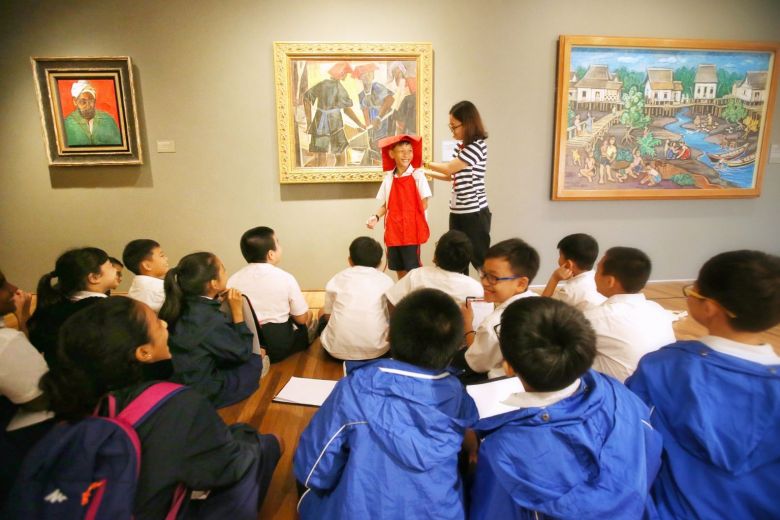(单词翻译:单击)
听力文本
Do Field Trips Help Students with Learning?
Trips to museums are part of many children's education in the United States. The American Alliance of Museums says museums receive about 55 million visits each year from students in school groups.
Many U.S. school systems are most concerned about students performing well on required math and science tests. Because of this, administrators and teachers might not see the value of art-related museum field trips.
This is where Jay Greene comes in. He is a professor of education policy at the University of Arkansas. He and his research team are studying how attending cultural events help a student's education. The National Endowment for the Arts supports part of their research.
Greene told VOA that his team wanted to learn how a single trip to an art museum affects a student. For this study, he and his team looked at 11,000 students.
"...And we found that students who visited an art museum were more tolerant, more empathetic, and also learned a lot of content about the art they saw and developed stronger critical thinking skills about art."
Greene explained that after one visit to the art museum, students averaged an eight percentile improvement on tolerance and empathy. He calls that a "moderate effect," but "impressive," considering that it was after just one visit to the art museum.
Melissa Reyes is with Crystal Bridges Museum of American Art in Bentonville, Arkansas. The museum has been involved with Greene's studies. Since 2012, the museum has had nearly 300,000 students come to visit. It also sends teaching artists to local classrooms.
Reyes said she agrees with Greene's findings on the effects of museum trips. She added that the greatest effect appears to be for students in rural areas, minority students and those who attend high-poverty schools.
Greene's researchers also examined how going to a live theater performance can affect students. This study involved a small number of subjects – about 1,500 students from 40 schools. The students were also older. They all lived in northwest Arkansas.
Green said his team found that students who saw a live performance "experienced improvement in tolerance and empathy."

A different group of students watched a movie version of the same play. Greene said they did not experience the same results as those who went to the live theater. The students who saw the live performance learned the story and related vocabulary better than those who watched the movie version, he said.
"So we think that there's something special about in-person cultural experiences that are different than simply digital experiences of those of those same stories."
Greene's team is now carrying out longer-term studies, in which they are following students over many years. He has already seen some promising results among students who have been visiting the Woodruff Arts Center in Atlanta, Georgia.
"Our most surprising result is that we saw improvements in math and reading test score performance for students in Atlanta after they went on multiple enriching field trips. We think that again that has to do with improving their motivation."
Greene says that the fact they did well on the tests "suggests that motivation is a very important part of success in school." This is true for students of all ages.
Students' behavior in school also improved. Greene thinks part of that may be because they were doing something fun in school.
"Because if the school doesn't do it for kids from more disadvantaged backgrounds, then it's possible these kids won't get much exposure to the arts at all."
And that, he says, may hurt their future.
Some museums, like Crystal Bridges Museum in Arkansas, are looking for ways to offer new programs for schools.
Melissa Reyes said that, in addition to their usual arts field trips, the museum also offers "STEM-based tours." STEM stands for science, technology, engineering and math—areas of great concern to many schools. Reyes explained that these tours look at connections "between art and science, art and math, and art and architecture."
She said, "these experiences complement learning goals in both the arts and the STEM categories."
I'm Anne Ball.
重点解析
重点讲解:
1. because of 采取措施;实施行动;
The game was postponed because of rain.
比赛因雨,延期了。
2. look at 考虑;注视;
We have set up a task force to look at the question of women returning to work.
我们已经成立了一个工作组去调查妇女复工的问题。
3. carry out 实行;开展;
I myself will firmly carry out this plan.
我本人将坚决执行这个计划。
4. stand for 代表;象征;
What does EU stand for?
EU代表什么?
参考译文
参观博物馆是否有助于提高学生的学业成绩?
参观博物馆是美国许多儿童接受教育的一部分。美国博物馆联盟表示,博物馆每年接待来自学校团体的学生约5500万人次参观。
许多美国学校系统最关心的是学生在必要的数学和自然科学的考试中表现良好。正因为如此,管理者和教师可能看不到与艺术相关的博物馆参观学习的价值。
杰伊·格林由此入手。他是阿肯色大学教育政策教授,他及其研究团队正在研究参加文化活动对学生教育的帮助。国家艺术基金会对他们的部分研究提供支持。
格林告诉美国之音,他的团队想了解艺术博物馆之旅对学生的影响。在这项研究中,他和他的团队调查了1.1万名学生。
“……我们发现,参观艺术博物馆的学生更宽容、更能感同身受,还学到了很多关于他们所看到的艺术品的内容,并培养了更强的艺术批判性思维能力。”
格林解释说,参观艺术博物馆后,学生在宽容度和同情心方面平均提高了八个百分点。这只是在参观美术馆一次之后出现的结果,他称其为“中等效力”,但却“令人印象深刻”。
梅丽莎·雷耶斯在阿肯色州本顿维尔的美国水晶桥艺术博物馆工作。该博物馆一直参与格林的研究。自2012年以来,已有近30万名学生前来参观博物馆。它还把教学艺术家分派到当地的学校进行教学。
雷耶斯说,她同意格林关于参观博物馆的作用的调查结果。她补充说,对农村地区的学生、少数民族学生和那些特穷学校的学生来说,影响效果似乎最大。
格林团队的研究人员还研究了去剧院观看现场演出对学生的影响。参与这项研究的研究对象数量较少,约有1500名学生,来自40所学校。学生们年龄也偏大,他们都住在阿肯色州西北部。
格林说,他的团队发现,观看现场表演的学生“在宽容度和同情心方面都有提高”
另一组学生观看同一部剧作的电影版本。格林说,他们没有体验到与那些去剧院观看现场表演的学生感受到的相同效果。他说,观看现场表演的学生比观看电影版的学生更好地学习了故事和相关词汇。
“因此,我们认为亲身经历的文化体验很特别,它与仅通过数字化模式学习相同故事存在不同之处。”。”
格林的团队现在正在进行长期性研究,他们对学生实施为期数年的追踪。他已经在参观过乔治亚州亚特兰大伍德拉夫艺术中心的学生中看到了一些可喜的结果。
“最令人惊讶的结果是,亚特兰大的学生进行多次丰富多彩的参观学习之后,我们看到他们的数学和阅读考试成绩都有所提高。我们认为,这还是与提高他们的学习动机有关。”
格林说,事实上他们在考试中表现很好,“表明学习动机是在学校取得好成绩的一个非常重要的部分。”所有年龄段的学生都是如此。
学生的在校行为也有所改善。格林认为,部分原因可能是由于他们在学校里做着一些有趣的事情。
“因为如果学校不为那些处境不太好的孩子做这些事,那么这些孩子很可能根本无法接触到艺术。”
他说,这可能会给他们的未来带来不良的影响。
一些博物馆,如阿肯色州的水晶桥艺术博物馆,正在寻找为学校提供新项目的途径。
梅利莎·雷耶斯表示,除了普通的艺术品参观外,博物馆还提供“STEM之旅”。STEM代表许多学校都非常关注的科学、技术、工程和数学领域。雷耶斯解释道,这些参观着眼于“艺术与科学、艺术与数学、艺术与建筑之间的联系。”
她说:“这些经验使艺术和STEM两个类别的学习目标互补。”
安妮·鲍尔报道。
译文为可可英语翻译,未经授权请勿转载!


